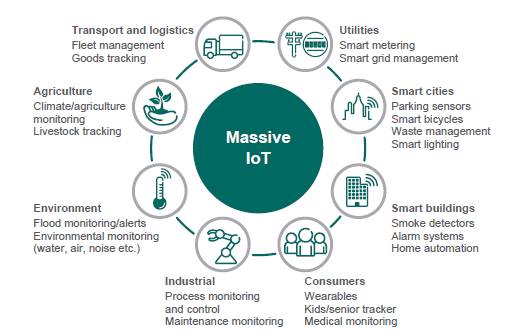Narrowband IoT (NB‑IoT) is a new way of communicating with “things” that require small amounts of data, over long periods, in hard to reach places.
Narrowband IoT (NB‑IoT), also known as LTE Cat. NB1, is a Low Power Wide Area (LPWA) technology that works virtually anywhere. It connects devices more simply and efficiently on already established mobile networks, and handles small amounts of fairly infrequent 2‑way data, securely and reliably. And the best is, it provides:
- very low power consumption
- excellent penetration coverage
- lower component costs
The Massive IoT market segment includes several applications widely used in industries and
societies.
The mobile industry is progressing toward commercialization of these new technologies driven by a high level of interest from the entire ecosystem. These new narrowband LTE IoT technologies provide a superior solution to emerging non-3GPP technologies for IoT and Low Power Wide Area (LPWA) applications. The benefits include:
- Ubiquitous coverage: Leverage existing LTE networks (~500 networks) in 160+ countries
- Scalability: Part of a unified platform that can scale from 10s of kbps to Gigabit-Class LTE
- Coexistence: Compatible with existing LTE networks, spectrum, and services
- Managed quality of service (QoS): Utilize licensed spectrum for guaranteed resource allocation
- End-to-end security: Established/trusted security and authentication features
Beyond these benefits, 3GPP is backed by a mature ecosystem with a rich roadmap to 5G. In fact, NB-IoT will continue to evolve beyond Release 13 with new features, such as support for multicast and positioning, establishing the foundation for Narrowband 5G IoT.
Use cases:

Smart metering
NB‑IoT is well suited for monitoring gas and water meters, via regular and small data transmissions. Network coverage is a key issue in smart metering rollouts. Meters have a very strong tendency to turn up in difficult locations, such as in cellars, deep underground or in remote rural areas. NB‑IoT has excellent coverage and penetration to address this issue.
Smart cities
NB‑IoT can help local government control street lighting, determine when waste bins need emptying, identify freeparking spaces, monitor environmental conditions, and survey the condition of roads.
Smart buildings
NB‑IoT connected sensors can send alerts about building maintenance issues and perform automated tasks, such aslight and heat control. NB‑IoT can also act as the backup for the building broadband connection. Some securitysolutions may even use LPWA networks to connect sensors directly to the monitoring system, as this configuration is more difficult for an intruder to disable as well as easier to install and maintain.
Consumers
NB‑IoT will provide wearable devices with their own long‑range connectivity, which is particularly beneficial for people and animal tracking. Similarly, NB‑IoT can also be used for health monitoring of those suffering from chronic or age‑related conditions.
Agricultural and environmental
NB‑IoT connectivity will offer farmers tracking possibilities, so that a sensor containing a u‑blox NB‑IoT module can send an alert if an animal’s movement is out of the ordinary. Such sensors could be used to monitor the temperature and humidity of soil, and in general to keep track of attributes of land, pollution, noise, rain, etc.




The answer of an exertp. Good to hear from you.